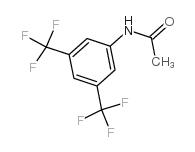16143-84-3
| Name | N-[3,5-bis(trifluoromethyl)phenyl]acetamide |
|---|---|
| Synonyms |
Essigsaeure-(3,5-bis-trifluormethyl-anilid)
MFCD00089454 N-(3,5-bis(trifluoromethyl)phenyl)acetamide 1-acetamido-3,5-bis(trifluoromethyl)benzene 3,5-DiCF3 acetanilide acetic acid-(3,5-bis-trifluoromethyl-anilide) GNF-Pf-1581 |
| Density | 1.43g/cm3 |
|---|---|
| Boiling Point | 262.6ºC at 760mmHg |
| Melting Point | 160 °C |
| Molecular Formula | C10H7F6NO |
| Molecular Weight | 271.15900 |
| Flash Point | 112.6ºC |
| Exact Mass | 271.04300 |
| PSA | 29.10000 |
| LogP | 3.75560 |
| Vapour Pressure | 0.0108mmHg at 25°C |
| Index of Refraction | 1.445 |
Synonym: Section 2 - COMPOSITION, INFORMATION ON INGREDIENTS
Risk Phrases: 22 Section 3 - HAZARDS IDENTIFICATION EMERGENCY OVERVIEW
Harmful if swallowed. Potential Health Effects Eye: May cause eye irritation. Skin: May cause skin irritation. May be harmful if absorbed through the skin. Ingestion: Harmful if swallowed. May cause irritation of the digestive tract. Inhalation: May cause respiratory tract irritation. May be harmful if inhaled. Chronic: Not available. Section 4 - FIRST AID MEASURES Eyes: Flush eyes with plenty of water for at least 15 minutes, occasionally lifting the upper and lower eyelids. Get medical aid. Skin: Get medical aid. Flush skin with plenty of water for at least 15 minutes while removing contaminated clothing and shoes. Ingestion: Get medical aid. Wash mouth out with water. Inhalation: Remove from exposure and move to fresh air immediately. If not breathing, give artificial respiration. If breathing is difficult, give oxygen. Get medical aid. Notes to Physician: Section 5 - FIRE FIGHTING MEASURES General Information: As in any fire, wear a self-contained breathing apparatus in pressure-demand, MSHA/NIOSH (approved or equivalent), and full protective gear. Extinguishing Media: Use water spray, dry chemical, carbon dioxide, or chemical foam. Section 6 - ACCIDENTAL RELEASE MEASURES General Information: Use proper personal protective equipment as indicated in Section 8. Spills/Leaks: Vacuum or sweep up material and place into a suitable disposal container. Section 7 - HANDLING and STORAGE Handling: Avoid breathing dust, vapor, mist, or gas. Avoid contact with skin and eyes. Storage: Store in a cool, dry place. Store in a tightly closed container. Section 8 - EXPOSURE CONTROLS, PERSONAL PROTECTION Engineering Controls: Use adequate ventilation to keep airborne concentrations low. Exposure Limits CAS# 16143-84-3: Personal Protective Equipment Eyes: Not available. Skin: Wear appropriate protective gloves to prevent skin exposure. Clothing: Wear appropriate protective clothing to prevent skin exposure. Respirators: Follow the OSHA respirator regulations found in 29 CFR 1910.134 or European Standard EN 149. Use a NIOSH/MSHA or European Standard EN 149 approved respirator if exposure limits are exceeded or if irritation or other symptoms are experienced. Section 9 - PHYSICAL AND CHEMICAL PROPERTIES Physical State: Solid Color: off-white Odor: Not available. pH: Not available. Vapor Pressure: Not available. Viscosity: Not available. Boiling Point: Not available. Freezing/Melting Point: 160 - 162 deg C Autoignition Temperature: Not available. Flash Point: Not available. Explosion Limits, lower: Not available. Explosion Limits, upper: Not available. Decomposition Temperature: Solubility in water: Specific Gravity/Density: Molecular Formula: C10H7F6NO Molecular Weight: 271 Section 10 - STABILITY AND REACTIVITY Chemical Stability: Not available. Conditions to Avoid: Incompatible materials. Incompatibilities with Other Materials: Acids, bases, oxidizing agents, reducing agents. Hazardous Decomposition Products: Nitrogen oxides, carbon monoxide, carbon dioxide, fluorine, hydrogen fluoride gas. Hazardous Polymerization: Has not been reported Section 11 - TOXICOLOGICAL INFORMATION RTECS#: CAS# 16143-84-3 unlisted. LD50/LC50: Not available. Carcinogenicity: N1-[3,5-Di(trifluoromethyl)phenyl]acetamide - Not listed by ACGIH, IARC, or NTP. Section 12 - ECOLOGICAL INFORMATION Section 13 - DISPOSAL CONSIDERATIONS Dispose of in a manner consistent with federal, state, and local regulations. Section 14 - TRANSPORT INFORMATION IATA No information available. IMO No information available. RID/ADR No information available. Section 15 - REGULATORY INFORMATION European/International Regulations European Labeling in Accordance with EC Directives Hazard Symbols: XN Risk Phrases: R 22 Harmful if swallowed. Safety Phrases: WGK (Water Danger/Protection) CAS# 16143-84-3: No information available. Canada None of the chemicals in this product are listed on the DSL/NDSL list. CAS# 16143-84-3 is not listed on Canada's Ingredient Disclosure List. US FEDERAL TSCA CAS# 16143-84-3 is not listed on the TSCA inventory. It is for research and development use only. SECTION 16 - ADDITIONAL INFORMATION N/A |
| Hazard Codes | Xi:Irritant; |
|---|---|
| Risk Phrases | R36/37/38 |
| Safety Phrases | S26-S36/37/39 |
| HS Code | 2924299090 |
|
~% 
16143-84-3 |
| Literature: Journal of the American Chemical Society, , vol. 68, p. 1602,1603 |
|
~96% 
16143-84-3 |
| Literature: The State of Oregon, acting by and through The Oregon State Board of Higher Education, acting for and on behalf of The Oregon Health Sciences University; The University of Oregon; The Regents of the University of California Patent: US5514680 A1, 1996 ; US 5514680 A |
|
~95% 
16143-84-3 |
| Literature: Tong, Xinli; Ren, Zhangshun; Que, Xiaolong; Yang, Qiwu; Zhang, Wenqin Research on Chemical Intermediates, 2012 , vol. 38, # 8 p. 1961 - 1968 |
|
~% 
16143-84-3 |
| Literature: Journal of the American Chemical Society, , vol. 68, p. 1602,1603 |
| HS Code | 2924299090 |
|---|---|
| Summary | 2924299090. other cyclic amides (including cyclic carbamates) and their derivatives; salts thereof. VAT:17.0%. Tax rebate rate:13.0%. . MFN tariff:6.5%. General tariff:30.0% |



